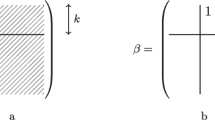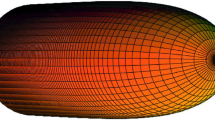Abstract
We review the correspondence between integrable sigma models with complex homogeneous target spaces and the chiral bosonic (and possibly mixed bosonic/fermionic) Gross–Neveu models. Mathematically, these are models with quiver variety phase spaces, which reduce to more conventional sigma models in special cases. We discuss the geometry of the models as well as their trigonometric and elliptic deformations, the Ricci flow, and the inclusion of fermions.

Similar content being viewed by others
Notes
The fact that the \(B\) field is topological is characteristic of symmetric space models. In general, it is a nonclosed 2-form.
References
Dmitri V. Bykov, “Flag manifold sigma models and nilpotent orbits,” Proc. Steklov Inst. Math., 309, 78–86 (2020); arXiv:1911.07768.
D. Bykov, “Quantum flag manifold \(\sigma\)-models and Hermitian Ricci flow,” arXiv:2006.14124.
D. Bykov, “The \(\mathbb{CP}^{n-1}\)-model with fermions: a new look,” to appear in Adv. Theor. Math. Phys.; arXiv:2009.04608.
I. Affleck, D. Bykov, and K. Wamer, “Flag manifold sigma models: spin chains and integrable theories,” arXiv:2101.11638.
H. Nakajima, “Instantons on ALE spaces, quiver varieties, and Kac–Moody algebras,” Duke Math. J., 76, 365–416 (1994).
E. Abdalla, M. C. B. Abdalla, and K. D. Rothe, Nonperturbative Methods in Two Dimensional Quantum Field Theory, World Sci., Singapore (1991).
D. J. Gross and A. Neveu, “Dynamical symmetry breaking in asymptotically free field theories,” Phys. Rev. D, 10, 3235–3253 (1974).
E. Witten, “Chiral symmetry, the \(1/n\) expansion, and the \(\mathrm{SU}(N)\) thirring model,” Nucl. Phys. B, 145, 110–118 (1978).
N. A. Nekrasov, “Lectures on curved beta-gamma systems, pure spinors, and anomalies,” arXiv:hep-th/0511008.
B. Fu, “A survey on symplectic singularities and symplectic resolutions,” Ann. Math. Blaise Pascal, 13, 209–236 (2006).
P. Breitenlohner and D. Maison, “On nonlinear \(\sigma\)-models arising in (super-)gravity,” Commun. Math. Phys., 209, 785–810 (2000); arXiv:gr-qc/9806002.
P. Breitenlohner, D. Maison, and G. W. Gibbons, “\(4\)-dimensional black holes from Kaluza–Klein theories,” Commun. Math. Phys., 120, 295–333 (1988).
O. Brodbeck and M. Zagermann, “Dimensionally reduced gravity, Hermitian symmetric spaces and the Ashtekar variables,” Class. Quant. Grav., 17, 2749–2763 (2000); arXiv:gr-qc/9911118.
A. Arvanitoyeorgos, “New invariant Einstein metrics on generalized flag manifolds,” Trans. Amer. Math. Soc., 337, 981–995 (1993).
V. E. Zakharov and A. V. Mikhailov, “Variational principle for equations integrable by the inverse problem method,” Funct. Anal. Appl., 14, 43–44 (1980).
L. Faddeev and N. Reshetikhin, “Integrability of the principal chiral field model in \((1+1)\)-dimension,” Ann. Phys., 167, 227–256 (1986).
C. Appadu, T. J. Hollowood, D. Price, and D. C. Thompson, “Quantum anisotropic sigma and lambda models as spin chains,” J. Phys. A: Math. Theor., 51, 405401, 42 pp. (2018); arXiv:1802.06016.
V. Caudrelier, M. Stoppato, and B. Vicedo, “On the Zakharov–Mikhailov action: 4d Chern–Simons origin and covariant Poisson algebra of the Lax connection,” arXiv:2012.04431.
O. Fukushima, J.-I. Sakamoto, and K. Yoshida, “Faddeev–Reshetikhin model from a 4D Chern–Simons theory,” JHEP, 02, 115, 18 pp. (2021); arXiv:2012.07370.
L. Faddeev and L. Takhtajan, Hamiltonian Methods in the Theory of Solitons, Springer, Berlin (2007).
A. A. Belavin and V. G. Drinfeld, “Solutions of the classical Yang–Baxter equation for simple Lie algebras,” Funct. Anal. Appl., 16, 159–180 (1982).
I. V. Cherednik, “Relativistically invariant quasiclassical limits of integrable two-dimensional quantum models,” Theoret. and Math. Phys., 47, 422–425 (1981).
C. Klimčík, “On integrability of the Yang–Baxter \(\sigma\)-model,” J. Math. Phys., 50, 043508, 22 pp. (2009); arXiv:0802.3518.
C. Klimčík, “Integrability of the bi-Yang–Baxter sigma-model,” Lett. Math. Phys., 104, 1095–1106 (2014); arXiv:1402.2105.
K. Sfetsos, “Integrable interpolations: From exact CFTs to non-Abelian T-duals,” Nucl. Phys. B, 880, 225–246 (2014); arXiv:1312.4560.
F. Delduc, M. Magro, and B. Vicedo, “On classical \(q\)-deformations of integrable \(\sigma\)-models,” JHEP, 11, 192, 37 pp. (2013); arXiv:1308.3581.
K. Zarembo, “Integrability in sigma-models,” in: Integrability: From Statistical Systems to Gauge Theory (Les Houches, France, 6 June – 1 July, 2016, P. Dorey, G. Korchemsky, N. Nekrasov, V. Schomerus, D. Serban, and L. Cugliandolo, eds.) Les Houches Lecture Notes, Vol. 106, Oxford Univ. Press, Oxford (2019), pp. 205–247; arXiv:1712.07725.
J. Zinn-Justin, Quantum Field Theory and Critical Phenomena, Clarendon Press, New York (2002).
S. V. Ketov, Quantum Non-linear Sigma-Models From Quantum Field Theory to Supersymmetry, Conformal Field Theory, Black Holes and Strings, Springer, Berlin (2000).
V. Fateev, E. Onofri, and Al. B. Zamolodchikov, “Integrable deformations of the \(\mathrm{O}(3)\) sigma model. The sausage model,” Nucl. Phys. B, 406, 521–565 (1993).
V. A. Fateev, “The sigma model (dual) representation for a two-parameter family of integrable quantum field theories,” Nucl. Phys. B, 473, 509–538 (1996).
G. Valent, C. C. Klimčík, and R. Squellari, “One loop renormalizability of the Poisson–Lie sigma models,” Phys. Lett. B, 678, 143–148 (2009); arXiv:0902.1459.
S. L. Lukyanov, “The integrable harmonic map problem versus Ricci flow,” Nucl. Phys. B, 865, 308–329 (2012); arXiv:1205.3201.
B. Hoare, N. Levine, and A. A. Tseytlin, “Integrable 2d sigma models: quantum corrections to geometry from RG flow,” Nucl. Phys. B, 949, 114798, 17 pp. (2019); arXiv:1907.04737.
B. Hoare, N. Levine, and A. A. Tseytlin, “Sigma models with local couplings: a new integrability-RG flow connection,” JHEP, 11, 020, 35 pp. (2020); arXiv:2008.01112.
F. Delduc, S. Lacroix, K. Sfetsos, and K. Siampos, “RG flows of integrable \(\sigma\)-models and the twist function,” JHEP, 02, 065, 45 pp. (2021); arXiv:2010.07879.
F. Hassler, “RG flow of integrable \(\mathcal{E}\)-models,” Phys. Lett. B, 818, 136367 (2021); arXiv:2012.10451.
K. Costello and M. Yamazaki, “Gauge theory and integrability, III,” arXiv:1908.02289.
K. Pohlmeyer, “Integrable Hamiltonian systems and interactions through quadratic constraints,” Commun. Math. Phys., 46, 207–221 (1976).
D. Bykov, “Complex structures and zero-curvature equations for \(\sigma\)-models,” Phys. Lett. B, 760, 341–344 (2016); arXiv:1605.01093.
A. G. Bytsko, “The zero-curvature representation for nonlinear \(O(3)\) sigma-model,” J. Math. Sci. (N. Y.), 85, 1619–1628 (1997); arXiv:hep-th/9403101.
F. Delduc, T. Kameyama, S. Lacroix, M. Magro, and B. Vicedo, “Ultralocal Lax connection for para-complex \(\mathbb Z_T\)-cosets,” Nucl. Phys. B, 949, 114821, 14 pp. (2019); arXiv:1909.00742.
V. V. Bazhanov, G. A. Kotousov, and S. L. Lukyanov, “Quantum transfer-matrices for the sausage model,” JHEP, 01, 021, 88 pp. (2018); arXiv:1706.09941.
A. D’adda, P. Di Vecchia, and M. Lüscher, “Confinement and chiral symmetry breaking in \(CP^{n_1}\) models with quarks,” Nucl. Phys. B, 152, 125–144 (1979).
N. Andrei and J. H. Lowenstein, “Diagonalization of the chiral-invariant Gross–Neveu Hamiltonian,” Phys. Rev. Lett., 43, 1698–1701 (1979).
C. Destri and H. J. de Vega, “Light-cone lattices and the exact solution of chiral fermion and sigma models,” J. Phys. A: Math. Gen., 22, 1329–1353 (1989).
Acknowledgments
I thank A. A. Slavnov for support and A. K. Pogrebkov for the invitation to give a talk at the “Polivanov-90” conference. Some of this material was also presented at the conferences “GLSMs-2020” (Virginia Tech, USA) and “RAQIS-2020” (Annecy, France), and I am grateful to the respective organizers E. Sharpe and E. Ragoucy for the invitations.
Funding
This work was supported by the Russian Science Foundation grant RSCF-20-72-10144.
Author information
Authors and Affiliations
Corresponding author
Ethics declarations
The author declares no conflicts of interest.
Additional information
Translated from Teoreticheskaya i Matematicheskaya Fizika, 2021, Vol. 208, pp. 165-179 https://doi.org/10.4213/tmf10103.
Rights and permissions
About this article
Cite this article
Bykov, D.V. Sigma models as Gross–Neveu models. Theor Math Phys 208, 993–1003 (2021). https://doi.org/10.1134/S0040577921080018
Received:
Revised:
Accepted:
Published:
Issue Date:
DOI: https://doi.org/10.1134/S0040577921080018




